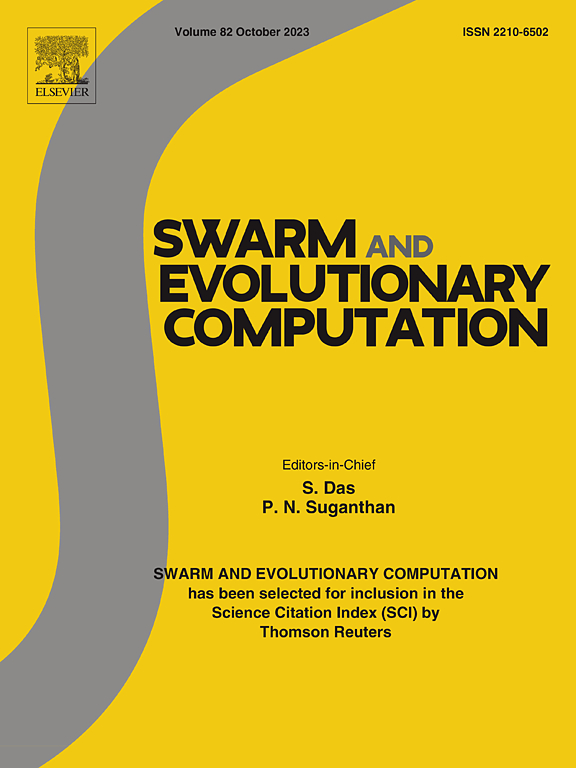Surrogate-assisted two-stage cooperative differential evolution for expensive constrained multimodal optimization problems
IF 8.2
1区 计算机科学
Q1 COMPUTER SCIENCE, ARTIFICIAL INTELLIGENCE
引用次数: 0
Abstract
The expensive calculation, constrained solution space and multimodal properties of expensive constrained multimodal optimization problems pose significant challenges for effective problem solving. Therefore, this study proposed a surrogate-assisted two-stage cooperative differential evolution algorithm, aiming to locate multiple optimal solutions at a low computational cost. The algorithm initially established a two-stage master–auxiliary problem cooperative framework to balance the search focus at various stages: the first stage emphasizes finding feasible regions, while the second stage focuses on tracking multiple modalities and locating the optimal solution within each modality. Then, to balance the feasibility, diversity, and accuracy of the solutions, a multi-indicator guided two-stage surrogate model management mechanism was proposed. Furthermore, a two-stage local search strategy for elite solutions was presented, which implements different local search schemes based on the existence of feasible solutions, in order to improve the quality of solutions while mining feasible ones. Finally, the proposed algorithm was compared with five existing expensive constrained surrogate-assisted evolutionary algorithms (SAEAs), one constrained multimodal evolutionary algorithm, and one expensive constrained multimodal SAEA. Experimental results on 21 benchmark problems and 1 rotor airfoil aerodynamic instance show that the proposed algorithm can obtain multiple highly competitive optimal solutions with less computational cost.

昂贵约束多模态优化问题的代理辅助两阶段协同微分进化
昂贵约束多模态优化问题的计算量大、求解空间受限以及多模态特性对有效求解提出了重大挑战。为此,本研究提出了一种代理辅助的两阶段协同差分进化算法,旨在以较低的计算成本找到多个最优解。该算法初步建立了主辅两阶段的问题协作框架,平衡各阶段的搜索重点:第一阶段侧重于寻找可行区域,第二阶段侧重于跟踪多个模态并在每个模态中找到最优解。然后,为了平衡解决方案的可行性、多样性和准确性,提出了一种多指标导向的两阶段代理模型管理机制。为了在挖掘可行解的同时提高解的质量,提出了精英解的两阶段局部搜索策略,该策略根据可行解的存在性实现不同的局部搜索方案。最后,将该算法与现有的5种昂贵约束代理辅助进化算法(SAEA)、1种约束多模态进化算法和1种昂贵约束多模态进化算法进行了比较。21个基准问题和1个旋翼型气动实例的实验结果表明,该算法能够以较小的计算量获得多个高度竞争的最优解。
本文章由计算机程序翻译,如有差异,请以英文原文为准。
求助全文
约1分钟内获得全文
求助全文
来源期刊

Swarm and Evolutionary Computation
COMPUTER SCIENCE, ARTIFICIAL INTELLIGENCEC-COMPUTER SCIENCE, THEORY & METHODS
CiteScore
16.00
自引率
12.00%
发文量
169
期刊介绍:
Swarm and Evolutionary Computation is a pioneering peer-reviewed journal focused on the latest research and advancements in nature-inspired intelligent computation using swarm and evolutionary algorithms. It covers theoretical, experimental, and practical aspects of these paradigms and their hybrids, promoting interdisciplinary research. The journal prioritizes the publication of high-quality, original articles that push the boundaries of evolutionary computation and swarm intelligence. Additionally, it welcomes survey papers on current topics and novel applications. Topics of interest include but are not limited to: Genetic Algorithms, and Genetic Programming, Evolution Strategies, and Evolutionary Programming, Differential Evolution, Artificial Immune Systems, Particle Swarms, Ant Colony, Bacterial Foraging, Artificial Bees, Fireflies Algorithm, Harmony Search, Artificial Life, Digital Organisms, Estimation of Distribution Algorithms, Stochastic Diffusion Search, Quantum Computing, Nano Computing, Membrane Computing, Human-centric Computing, Hybridization of Algorithms, Memetic Computing, Autonomic Computing, Self-organizing systems, Combinatorial, Discrete, Binary, Constrained, Multi-objective, Multi-modal, Dynamic, and Large-scale Optimization.
 求助内容:
求助内容: 应助结果提醒方式:
应助结果提醒方式:


